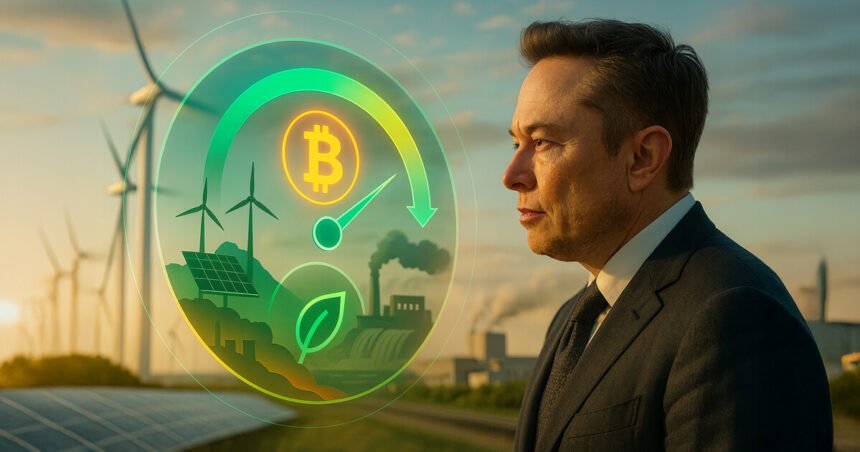Elon Musk recently reinstated the “51% renewable energy” benchmark and said the energy behind Bitcoin “can’t be faked.”
The mention refers to his previous promise that Tesla would resume accepting Bitcoin payments once at least half of the energy it mines comes from clean or low-carbon sources.
However, Tesla has yet to re-enable BTC checkout, although the latest data suggests the network may have crossed that threshold. Why?
Has Bitcoin reached its limit yet?
According to the Cambridge Center for Alternative Finance’s 2025 Digital Mining Industry Report, approximately 52.4% of surveyed Bitcoin mining activity is currently powered by sustainable energy.
Of this, 42.6% comes from renewable energy (hydro, wind, solar, etc.) and 9.8% from nuclear or other low-carbon sources. In parallel, the contribution of fossil fuels has also changed, with natural gas now accounting for 38.2% (up from about 25% in 2022) and coal falling to 8.9% (down from about 36.6%).

If we take Musk’s promise literally, Bitcoin could already pass the 51% “sustainable energy” threshold, at least as measured by a Cambridge survey of companies covering about 48% of the world’s mining capacity.
But this is only half the story. Wording is important. Musk mentioned renewable energy (50%) in his earlier comments, but in a subsequent tweet he also said it was “51% renewable” or “energy that can’t be faked.” The Cambridge figures lump renewable energy and nuclear energy together. The share of pure renewable energy is lower (42.6%).
Therefore, depending on the strictness of Mr. Musk’s definition, BTC may still fall short.
Additionally, the Cambridge approach is research-based and only targets a select group of minors. Off-grid operations, renewable energy reductions, regional specificities, and temporal mismatches (where renewable energy generation occurs more or less than mining demand) complicate the situation.
Alternative models, such as models based on grid carbon intensity or energy tracking, often yield more conservative estimates of the share of renewable energy. This disconnect means that even a nominal “pass” is subject to debate.
So why didn’t Tesla flip the switch?
Even acknowledging that Bitcoin may be subject to Musk’s sustainability tests, Tesla has not re-enabled Bitcoin payments. Several practical and symbolic hurdles remain.
The first is due diligence. Musk previously said Tesla would only resume payments if it saw “reasonable (about 50%) clean energy usage…and a trend toward increasing that number.” This wording suggests he’s looking for permanence rather than a one-time data point.
A single report showing 52% sustainable energy may not meet his requirement of a verified sustained upward trend in Bitcoin’s energy mix.
Another factor is clarity of definition. Tesla needs to decide whether “sustainable” includes nuclear power and low-carbon sources, or fully renewable energy such as hydro, wind and solar power. The Cambridge data combines these categories, but Musk’s previous language specifically referred to renewable energy.
Without a widely accepted definition, the decision to restart BTC payments risks being accused of greenwashing.
There is also the issue of seller and market risk. Accepting Bitcoin exposes Tesla to price volatility, complex accounting, and potential regulatory complications.
Even if the company were to immediately convert its BTC receipts into fiat currency, the fluctuations between order placement and settlement create financial uncertainty that may not be worth the effort for automakers with low profit margins.
Branded optical elements add a new layer. Tesla’s image is built on environmental credibility, and even a slight setback in Bitcoin’s energy profile could cause a backlash from investors and ESG-minded customers. The company may be better off erring on the side of caution rather than exposing itself to new criticism if mining operations return to fossil-rich areas.
Finally, operational integration cannot be ignored. To bring Bitcoin payments back online, Tesla will need to rebuild its wallet infrastructure, transaction pipeline, and conversion mechanism. It requires engineering resources and internal approval. This step is no small feat for a global manufacturer already balancing multiple product launches and software initiatives.
Taken together, these factors show that meeting the 51% renewable energy standard is not enough. For Musk, this test seems to be as much about confidence, consistency and awareness as raw data. Until these match, Tesla’s checkout page will likely remain unencrypted.
What this means for adoption
From a narrative perspective, Musk’s re-engagement has had an impact. A more sustainable story for cryptocurrencies will be strengthened if Bitcoin can reliably transition to a cleaner energy mix and major commercial deals like Tesla can start trading again.
However, Tesla’s continued off-chain status despite the claims suggests that Musk views the promise as conditional rather than automatic. This test focuses not only on simple metrics but also on optics, risk management, and narrative.
For now, Bitcoin’s claimed “more than 51% sustainable” status is a convincing rebuttal to its critics, but until checkouts return, it will remain more of a symbolic victory than a commercial one.
(Tag Translation) Bitcoin


